-
LMP91002 Sensor AFE System: Configurable AFE Potentiostat for Low-Power Chemical Sensing Applications
- 1 Features
- 2 Applications
- 3 Description
- 4 Revision History
- 5 Pin Configuration and Functions
- 6 Specifications
- 7 Detailed Description
- 8 Application and Implementation
- 9 Power Supply Recommendations
- 10Layout
- 11Device and Documentation Support
- 12Mechanical, Packaging, and Orderable Information
- IMPORTANT NOTICE
Package Options
Mechanical Data (Package|Pins)
- NHL|14
Thermal pad, mechanical data (Package|Pins)
Orderable Information
LMP91002 Sensor AFE System: Configurable AFE Potentiostat for Low-Power Chemical Sensing Applications
1 Features
- Typical Values, TA = 25°C
- Supply Voltage 2.7 V to 3.6 V
- Supply Current (Average Over Time) < 10 µA
- Cell Conditioning Current Up to 10 mA
- Reference Electrode Bias Current (85°C) 900-pA (Maximum)
- Output Drive Current 750 µA
- Complete Potentiostat Circuit to Interface to Most Not Biased Gas Sensors
- Low Bias Voltage Drift
- Programmable TIA Gain 2.75 kΩ to 350 kΩ
- I2C-Compatible Digital Interface
- Ambient Operating Temperature –40°C to 85°C
- Package 14-pin WSON
- Supported by Webench Sensor AFE Designer
2 Applications
- Gas Detectors
- Amperometric Applications
- Electrochemical Blood Glucose Meters
3 Description
The LMP91002 device is a programmable Analog Front End (AFE) for use in micro-power electrochemical-sensing applications. It provides a complete signal path solution between a not biased gas sensor and a microcontroller generating an output voltage proportional to the cell current.
The LMP91002’s programmability enables it support not biased electro-chemical gas sensor with a single design. The LMP91002 supports gas sensitivities over a range of 0.5 nA/ppm to 9500 nA/ppm. It also allows for an easy conversion of current ranges from 5 μA to 750 μA full scale. The LMP91002’s transimpedance amplifier (TIA) gain is programmable through the I2C interface. The I2C interface can also be used for sensor diagnostics. The LMP91002 is optimized for micro-power applications and operates over a voltage range of 2.7 V to 3.6 V. The total current consumption can be less than 10 μA. Further power savings are possible by switching off the TIA amplifier and shorting the reference electrode to the working electrode with an internal switch.
Device Information(1)
| PART NUMBER | PACKAGE | BODY SIZE (NOM) |
|---|---|---|
| LMP91002 | WSON (14) | 4.00 mm × 4.00 mm |
- For all available packages, see the orderable addendum at the end of the data sheet.
Typical Application

4 Revision History
Changes from A Revision (March 2013) to B Revision
- Added ESD Ratings table, Feature Description section, Device Functional Modes, Application and Implementation section, Power Supply Recommendations section, Layout section, Device and Documentation Support section, and Mechanical, Packaging, and Orderable Information section.Go
Changes from * Revision (March 2013) to A Revision
- Changed layout of National Data Sheet to TI formatGo
5 Pin Configuration and Functions
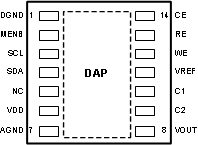
Pin Functions(1)
| PIN | I/O | DESCRIPTION | |
|---|---|---|---|
| NO. | NAME | ||
| 1 | DGND | G | Connect to ground |
| 2 | MENB | D | Module Enable. Active Low |
| 3 | SCL | D | I2C Clock |
| 4 | SDA | D | I2C Data |
| 5 | NC | — | Do not connect. Not internally connected |
| 6 | VDD | P | Voltage supply |
| 7 | AGND | GND | Analog GND |
| 8 | VOUT | A | Analog voltage representing sensor output |
| 9 | C2 | A | Optional External component node 2 for TIA (filter capacitor or gain resistor) |
| 10 | C1 | A | Optional External component node 1 for TIA (filter capacitor or gain resistor) |
| 11 | VREF | A | External Reference voltage input |
| 12 | WE | A | Working Electrode of the sensor. |
| 13 | RE | A | Reference Electrode of the sensor. |
| 14 | CE | A | Counter Electrode of the sensor. |
| — | DAP | GND | Die attached pad. Connect to GND. |
6 Specifications
6.1 Absolute Maximum Ratings
See (1)(2)(3)| MIN | MAX | UNIT | ||
|---|---|---|---|---|
| Voltage between any two pins | 6 | V | ||
| Current through VDD or VSS | 50 | mA | ||
| Current sunk and sourced by CE pin | 10 | mA | ||
| Current out of other pins(2) | 5 | mA | ||
| Junction temperature(2) | 150 | °C | ||
| Storage temperature, Tstg | –65 | 150 | °C | |
6.2 ESD Ratings
| VALUE | UNIT | |||
|---|---|---|---|---|
| V(ESD) | Electrostatic discharge | Human body model (HBM), per ANSI/ESDA/JEDEC JS-001(1)(3) | ±2000 | V |
| Charged-device model (CDM), per JEDEC specification JESD22-C101(2) | ±1000 | |||
| Machine Model (MM) | ±200 | |||
6.3 Recommended Operating Conditions
| MIN | MAX | UNIT | ||
|---|---|---|---|---|
| Supply voltage VS = (VDD - AGND) | 2.7 | 3.6 | V | |
| Temperature(1) | –40 | 85 | °C | |
6.4 Thermal Information
| THERMAL METRIC(1) | LMP91002 | UNIT | |
|---|---|---|---|
| NHL (WSON) | |||
| 14 PINS | |||
| RθJA | Junction-to-ambient thermal resistance (2) | 44 | °C/W |
6.5 Electrical Characteristics
Unless otherwise specified, all limits ensured for TA = 25°C, VS= (VDD – AGND), VS= 3.3 V and AGND = DGND = 0 V, VREF = 2.5 V, Internal Zero = 20% VREF.(1)| PARAMETER | TEST CONDITIONS | MIN(4) | TYP(2) | MAX(4) | UNIT | ||
|---|---|---|---|---|---|---|---|
| POWER SUPPLY SPECIFICATION | |||||||
| IS | Supply current | 3-lead amperometric cell mode MODECN = 0x03 |
TA = 25ºC | 10 | 13.5 | µA | |
| At the temperature extremes | 15 | ||||||
| Standby mode MODECN = 0x02 |
TA = 25ºC | 6.5 | 8 | ||||
| At the temperature extremes | 10 | ||||||
| Deep sleep mode MODECN = 0x00 |
TA = 25ºC | 0.6 | 0.85 | ||||
| At the temperature extremes | 1 | ||||||
| POTENTIOSTAT | |||||||
| IRE | Input bias current at RE pin | VDD = 2.7 V; Internal zero 50% VDD |
TA = 25ºC | –90 | 90 | pA | |
| At the temperature extremes | –800 | 800 | |||||
| VDD = 3.6 V; Internal zero 50% VDD |
TA = 25ºC | –90 | 90 | ||||
| At the temperature extremes | –900 | 900 | |||||
| ICE | Minimum operating current capability | Sink | 750 | µA | |||
| Source | 750 | ||||||
| Minimum charging capability(5) | Sink | 10 | mA | ||||
| Source | 10 | ||||||
| AOL_A1 | Open-loop voltage gain of control loop operational amplifier (A1) | 300 mV ≤ VCE ≤ Vs – 300 mV, –750 µA ≤ ICE ≤ 750 µA |
TA = 25ºC | 120 | dB | ||
| At the temperature extremes | 104 | ||||||
| en_RW | Low frequency integrated noise between RE pin and WE pin | 0.1 Hz to 10 Hz(6) | 3.4 | µVpp | |||
| VOS_RW | WE voltage offset referred to RE | 0% VREF, internal zero = 20% VREF, at the temperature extremes |
–550 | 550 | µV | ||
| 0% VREF, internal zero = 50% VREF, at the temperature extremes |
–550 | 550 | |||||
| 0% VREF, internal zero = 67% VREF, at the temperature extremes |
–550 | 550 | |||||
| TcVOS_RW | WE voltage offset drift referred to RE from –40°C to 85°C(3) | 0% VREF, internal zero = 20% VREF | –4 | 4 | µV/°C | ||
| 0% VREF, internal zero = 50% VREF | –4 | 4 | |||||
| 0% VREF, internal zero = 67% VREF | –4 | 4 | |||||
| TIA_GAIN | Transimpedance gain accuracy | 5% | |||||
| Linearity | ±0.05% | ||||||
| Programmable TIA gains | 7 programmable gain resistors | 2.75 3.5 7 14 35 120 350 |
kΩ | ||||
| Maximum external gain resistor | 350 | ||||||
| TIA_ZV | Internal zero voltage | 3 programmable percentages of VREF | 20% 50% 67% |
||||
| 3 programmable percentages of VDD | 20% 50% 67% |
||||||
| Internal zero voltage accuracy | ±0.04% | ||||||
| RL | Load resistor | 10 | Ω | ||||
| Load accuracy | 5% | ||||||
| PSRR | Power supply rejection ratio at RE pin | 2.7 V ≤ VDD ≤ 5.25 V | Internal zero 20% VREF | 80 | 110 | dB | |
| Internal zero 50% VREF | 80 | 110 | |||||
| Internal zero 67% VREF | 80 | 110 | |||||
| EXTERNAL REFERENCE SPECIFICATION(3) | |||||||
| VREF | External voltage reference range | 1.5 | VDD | V | |||
| Input impedance | 10 | MΩ | |||||
6.6 I2C Interface
Unless otherwise specified, all limits ensured for at TA = 25°C, VS= (VDD – AGND), 2.7 V <VS< 3.6 V and AGND = DGND = 0 V, VREF = 2.5 V.(1)| PARAMETER | TEST CONDITIONS | MIN(2) | TYP(4) | MAX(2) | UNIT | ||
|---|---|---|---|---|---|---|---|
| VIH | Input High Voltage | At the temperature extremes | 0.7*VDD | V | |||
| VIL | Input Low Voltage | At the temperature extremes | 0.3*VDD | V | |||
| VOL | Output Low Voltage | IOUT = 3 mA, at the temperature extremes | 0.4 | V | |||
| Hysteresis(3) | At the temperature extremes | 0.1*VDD | V | ||||
| CIN | Input Capacitance on all digital pins | At the temperature extremes | 0.5 | pF | |||
6.7 Timing Characteristics
Unless otherwise specified, all limits ensured for TA = 25°C, VS= (VDD – AGND), VS= 3.3 V and AGND = DGND = 0 V, VREF = 2.5 V, Internal Zero= 20% VREF. All limits apply at the temperature extremes. Refer to timing diagram in Figure 1(1).| PARAMETER | TEST CONDITIONS | MIN | TYP | MAX | UNIT | ||
|---|---|---|---|---|---|---|---|
| fSCL | Clock Frequency | At the temperature extremes | 10 | 100 | kHz | ||
| tLOW | Clock Low Time | At the temperature extremes | 4.7 | µs | |||
| tHIGH | Clock High Time | At the temperature extremes | 4 | µs | |||
| tHD;STA | Data valid | After this period, the first clock pulse is generated at the temperature extremes | 4 | µs | |||
| tSU;STA | Set-up time for a repeated START condition | At the temperature extremes | 4.7 | µs | |||
| tHD;DAT | Data hold time(4)
|
At the temperature extremes | 0 | ns | |||
| tSU;DAT | Data Set-up time | At the temperature extremes | 250 | ns | |||
| tf | SDA fall time(5) | IL ≤ 3 mA, CL ≤ 400 pF, at the temperature extremes |
250 | ns | |||
| tSU;STO | Set-up time for STOP condition | At the temperature extremes | 4 | µs | |||
| tBUF | Bus free time between a STOP and START condition | At the temperature extremes | 4.7 | µs | |||
| tVD;DAT | Data valid time | At the temperature extremes | 3.45 | µs | |||
| tVD;ACK | Data valid acknowledge time | At the temperature extremes | 3.45 | µs | |||
| tSP | Pulse width of spikes that must be suppressed by the input filter(5) | At the temperature extremes | 50 | ns | |||
| t_timeout | SCL and SDA Timeout | At the temperature extremes | 25 | 100 | ms | ||
| tEN;START | I2C Interface Enabling | At the temperature extremes | 600 | ns | |||
| tEN;STOP | I2C Interface Disabling | At the temperature extremes | 600 | ns | |||
| tEN;HIGH | time between consecutive I2C interface enabling and disabling | At the temperature extremes | 600 | ns | |||
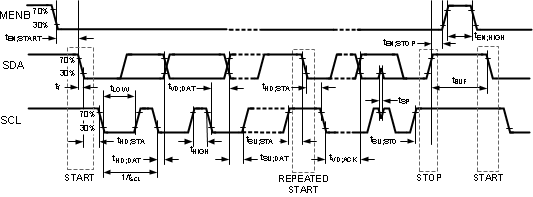 Figure 1. I2C Interface Timing Diagram
Figure 1. I2C Interface Timing Diagram
6.8 Typical Characteristics
Unless otherwise specified, TA = 25°C, VS= (VDD – AGND), 2.7 V <VS< 3.6 V and AGND = DGND = 0 V, VREF = 2.5 V.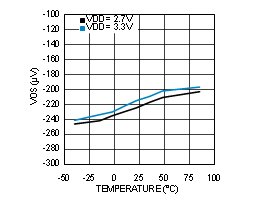 Figure 2. Input VOS_RW vs Temperature
Figure 2. Input VOS_RW vs Temperature
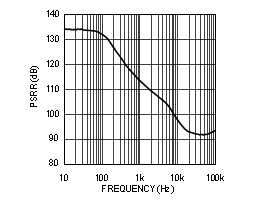 Figure 4. AC PSRR vs Frequency
Figure 4. AC PSRR vs Frequency
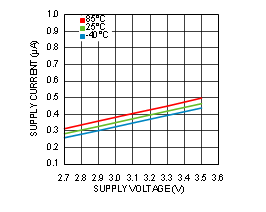 Figure 6. Supply Current vs VDD (Deep Sleep Mode)
Figure 6. Supply Current vs VDD (Deep Sleep Mode)
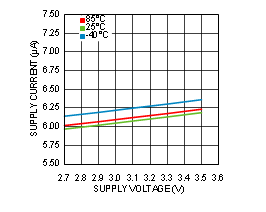 Figure 8. Supply Current vs VDD (Standby Mode)
Figure 8. Supply Current vs VDD (Standby Mode)
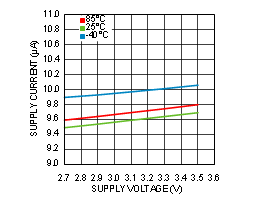 Figure 10. Supply Current vs VDD (3-Lead Amperometric Mode)
Figure 10. Supply Current vs VDD (3-Lead Amperometric Mode)
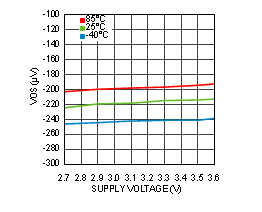 Figure 3. Input VOS_RW vs VDD
Figure 3. Input VOS_RW vs VDD
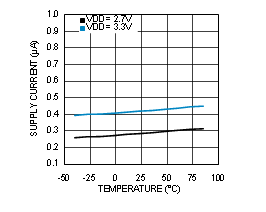 Figure 5. Supply Current vs Temperature (Deep Sleep Mode)
Figure 5. Supply Current vs Temperature (Deep Sleep Mode)
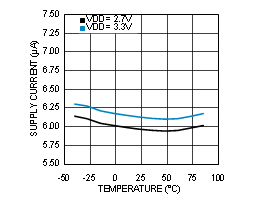 Figure 7. Supply Current vs Temperature (Standby Mode)
Figure 7. Supply Current vs Temperature (Standby Mode)
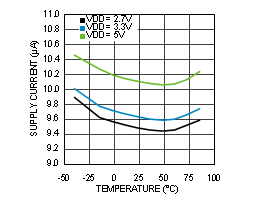 Figure 9. Supply Current vs Temperature (3-Lead Amperometric Mode)
Figure 9. Supply Current vs Temperature (3-Lead Amperometric Mode)
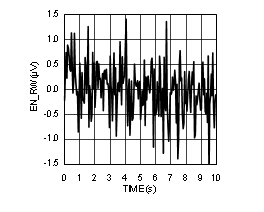 Figure 11. 0.1-Hz to 10-Hz Noise
Figure 11. 0.1-Hz to 10-Hz Noise